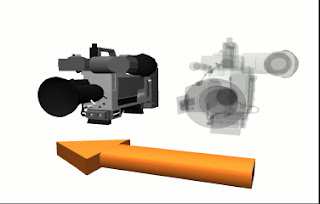Wednesday, February 24, 2010
Thursday, February 18, 2010
Wednesday, February 17, 2010
Saturday, February 13, 2010
Wednesday, February 10, 2010
Page 62: Shot List: Metropolis: Opening Scene
These are the scenes I reverse storyboarded, they are on youTube(please note the music is not the original music, I like the original music much better but I could not find the film sections I wanted on youtube):






Wokers' City
Opening Title
I chose the opening scene of Metropolis for the exercise on Page 62:






Chapter 3, Text, Image and Diagram
This chapter presents the interworkings of Text Diagram and Images in the process of preproduction visualization.
The elements of a visual shot are as follows:
Scale
Angle
Camera Move,
Character Blocking
Dialog or Action
Also discussed in this chapter are: Overhead Diagram,sidebar Diagram, shotlist terminology and numbering system.
I really like the summary of this chapter, so I am going to reproduce it here!
The Text: A shot list that alludes to visual aspects of the frame in words, using a specific vocabulary
The Diagram: An overhead view of the set with camera positions and character blocking marked down using icons and arrows. this document is both abstract and concrete in its use of simplified forms and scale drawing.
The Image: a drawing or photo based image that describes the composition of the frame. the most concrete of all the storyboarding documents, it shows the content of the shot in static or extended frames that refere to the movement of the camera.
The elements of a visual shot are as follows:
Scale
Angle
Camera Move,
Character Blocking
Dialog or Action
Also discussed in this chapter are: Overhead Diagram,sidebar Diagram, shotlist terminology and numbering system.
I really like the summary of this chapter, so I am going to reproduce it here!
The Text: A shot list that alludes to visual aspects of the frame in words, using a specific vocabulary
The Diagram: An overhead view of the set with camera positions and character blocking marked down using icons and arrows. this document is both abstract and concrete in its use of simplified forms and scale drawing.
The Image: a drawing or photo based image that describes the composition of the frame. the most concrete of all the storyboarding documents, it shows the content of the shot in static or extended frames that refere to the movement of the camera.
Thursday, February 4, 2010
Chapter 2, Storyboards in Preproduction
The focus of this chapter is on defining storyboarding, materials used to create it, and what it depicts, why it is needed, who creates it, and how, where and when it is created.
Types of storyboarding:
Editorial Storyboarding
Key Frames
Production Illustration
Commercial Boards
The list goes from simple sketches for the editorial Storyboarding to highly rendered color images for commercial spots.
Focus of this book is on Editorial Storyboarding.
Scenes that have priority in being storyboarded:
1- Special Effects Shot
2- Stunts and pyrotechnics
3- Crowd Scenes
4- Action
5- Complex Camera Movements
6- Montage Scenes: Montage sequences often appear in the written script as no more than a sentence or two that instructs the director to describe a passage of time using a whirlwind of images with little or no dialogue.
7-Opening and Closing Scenes
Types of storyboarding:
Editorial Storyboarding
Key Frames
Production Illustration
Commercial Boards
The list goes from simple sketches for the editorial Storyboarding to highly rendered color images for commercial spots.
Focus of this book is on Editorial Storyboarding.
Scenes that have priority in being storyboarded:
1- Special Effects Shot
2- Stunts and pyrotechnics
3- Crowd Scenes
4- Action
5- Complex Camera Movements
6- Montage Scenes: Montage sequences often appear in the written script as no more than a sentence or two that instructs the director to describe a passage of time using a whirlwind of images with little or no dialogue.
7-Opening and Closing Scenes
Subscribe to:
Comments (Atom)





 camera movements: pan right, tilt up, Dolly in
camera movements: pan right, tilt up, Dolly in painting by Simon Garden
painting by Simon Garden